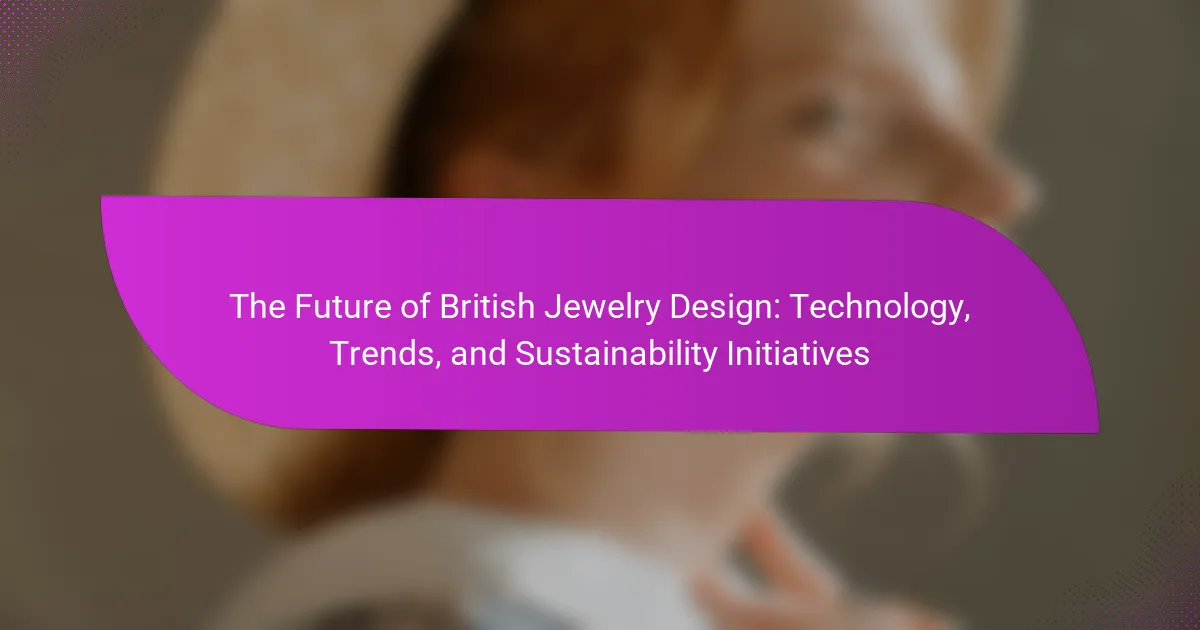The article focuses on the future of British jewelry design, emphasizing the influence of technology, sustainability, and changing consumer preferences. It outlines how advancements such as 3D printing and augmented reality will enhance design efficiency and creativity. The piece highlights the importance of sustainable practices, including the use of ethically sourced materials and environmentally friendly production methods, which are becoming essential to meet consumer demand for personalized and bespoke jewelry. Additionally, the integration of smart technology in jewelry is discussed as a way to appeal to tech-savvy consumers while preserving the industry’s rich heritage. Overall, the article examines how these trends will shape the British jewelry industry and attract a younger audience.

What is the Future of British Jewelry Design?
The future of British jewelry design is expected to be shaped by technology, sustainability, and evolving consumer preferences. Advances in technology, such as 3D printing and augmented reality, will enable designers to create intricate pieces more efficiently. Sustainability initiatives will drive the use of ethically sourced materials and environmentally friendly production methods. Trends indicate a growing demand for personalized and bespoke jewelry, reflecting individual identities. Additionally, the integration of smart technology into jewelry will enhance functionality and appeal to tech-savvy consumers. The British jewelry industry is poised to innovate while maintaining its rich heritage. This evolution will likely attract a younger audience, ensuring relevance in a competitive market.
How is technology shaping the future of British jewelry design?
Technology is significantly shaping the future of British jewelry design through innovative techniques and materials. 3D printing allows designers to create intricate patterns that were previously impossible. This technology reduces waste by using only the necessary amount of material. Additionally, computer-aided design (CAD) software enhances precision and customization options for consumers. Virtual reality (VR) is also being utilized for immersive design experiences. Brands can showcase their collections in virtual environments, reaching a wider audience. Furthermore, blockchain technology is improving transparency in sourcing materials. This ensures ethical practices and builds consumer trust. Overall, technology is driving efficiency, creativity, and sustainability in British jewelry design.
What technological innovations are being adopted in jewelry design?
3D printing is a significant technological innovation being adopted in jewelry design. It allows designers to create intricate and customizable pieces with precision. This technology reduces waste by using only the necessary materials. CAD (Computer-Aided Design) software is also widely used for designing complex jewelry forms. It enhances creativity and accuracy in the design process. Moreover, laser engraving technology enables detailed personalization on jewelry items. These innovations streamline production and improve the overall quality of jewelry. According to a report by Grand View Research, the global 3D printing market in jewelry is expected to grow significantly, indicating its increasing adoption in the industry.
How do these technologies enhance the design process?
Technologies enhance the design process by streamlining workflows and improving precision. Tools like CAD software allow designers to create intricate models quickly. 3D printing enables rapid prototyping, reducing the time from concept to production. Virtual reality tools allow for immersive design experiences, enhancing creativity. These technologies also facilitate collaboration among designers and clients, improving communication. Data analytics can inform design choices based on market trends and consumer preferences. According to a report by McKinsey, companies using advanced technologies in design see up to 30% faster project delivery times.
What trends are emerging in British jewelry design?
Emerging trends in British jewelry design include a focus on sustainability, innovative materials, and personalization. Designers are increasingly using recycled metals and ethically sourced gemstones. This shift aligns with consumer demand for environmentally friendly products. Technology integration is also notable, with 3D printing enabling unique designs. Customization options are growing, allowing consumers to create personalized pieces. Additionally, bold colors and unconventional shapes are gaining popularity. These trends reflect a broader movement towards individuality and ethical responsibility in fashion.
Which styles and materials are gaining popularity?
Sustainable materials and minimalist designs are gaining popularity in British jewelry design. Eco-friendly options include recycled metals and lab-grown gemstones. These materials reduce environmental impact while maintaining aesthetic appeal. Minimalist styles emphasize simplicity and elegance. They often feature clean lines and understated designs. According to a recent survey by the British Jewelry Association, 65% of consumers prefer sustainable jewelry options. This trend reflects a growing awareness of ethical consumption in the market.
How are consumer preferences influencing these trends?
Consumer preferences are significantly shaping trends in British jewelry design. Increased demand for sustainable materials drives designers to adopt eco-friendly practices. Consumers prioritize ethical sourcing, prompting brands to be transparent about their supply chains. The popularity of personalized jewelry reflects a shift towards unique, custom pieces. Digital technology influences design processes, with consumers favoring innovative techniques. Social media platforms allow consumers to influence trends through shared aesthetics and feedback. The rise of minimalist designs aligns with consumer preferences for simplicity and elegance. Overall, consumer preferences are steering the jewelry industry toward sustainability, personalization, and technology integration.
What sustainability initiatives are being implemented in British jewelry design?
British jewelry design is increasingly focused on sustainability initiatives. Many designers are using recycled metals to reduce environmental impact. Ethical sourcing of gemstones is also a priority. Designers are opting for lab-grown diamonds as a sustainable alternative. Additionally, some brands are adopting transparent supply chains to ensure ethical practices. Eco-friendly packaging is being implemented to minimize waste. Collaborations with environmental organizations are becoming common. These initiatives reflect a growing commitment to sustainability in the British jewelry industry.
How are designers addressing environmental concerns?
Designers are addressing environmental concerns by adopting sustainable materials and practices. They prioritize using recycled metals and ethically sourced gemstones. Many designers implement eco-friendly production methods to reduce waste. They also focus on creating timeless designs to promote longevity over fast fashion. Innovations in technology, such as 3D printing, minimize material waste. Additionally, designers are increasingly transparent about their supply chains. This transparency builds consumer trust and encourages responsible purchasing. Research indicates that 66% of consumers are willing to pay more for sustainable brands.
What materials are considered sustainable in jewelry production?
Sustainable materials in jewelry production include recycled metals, ethically sourced gemstones, and lab-grown diamonds. Recycled metals reduce the need for mining, which is environmentally damaging. Ethically sourced gemstones ensure fair labor practices and minimal environmental impact. Lab-grown diamonds offer a conflict-free alternative to mined diamonds. According to the World Gold Council, recycled gold uses 99% less energy than newly mined gold. This demonstrates that sustainable practices can significantly lower the environmental footprint of jewelry production.

How are technology and sustainability interconnected in jewelry design?
Technology and sustainability in jewelry design are interconnected through the use of innovative materials and processes. Advanced technologies enable the creation of sustainable alternatives, such as lab-grown diamonds and recycled metals. These materials reduce environmental impact compared to traditional mining practices. Additionally, 3D printing technology allows for efficient production, minimizing waste. Digital tools also enhance design precision, leading to less resource consumption. Research indicates that sustainable practices can improve brand reputation and customer loyalty. Therefore, technology plays a critical role in promoting sustainable practices in the jewelry industry.
What role does technology play in promoting sustainability?
Technology plays a crucial role in promoting sustainability by enabling efficient resource management. It allows for the development of eco-friendly materials and processes. For example, advancements in 3D printing reduce waste during production. Renewable energy technologies, such as solar and wind, decrease reliance on fossil fuels. Data analytics helps optimize supply chains, minimizing carbon footprints. Smart technologies improve energy efficiency in manufacturing. Additionally, blockchain enhances transparency in sourcing materials, ensuring ethical practices. These technological innovations collectively contribute to a more sustainable future.
How can 3D printing reduce waste in jewelry production?
3D printing can significantly reduce waste in jewelry production by enabling precise manufacturing. Traditional methods often result in excess material due to cutting and shaping processes. In contrast, 3D printing creates items layer by layer, minimizing leftover material. This technology allows for the design of intricate pieces without the need for extensive material removal. Additionally, it supports the use of recycled materials, further decreasing waste. A study by the University of Exeter found that 3D printing can reduce material waste by up to 90% compared to traditional techniques. Thus, 3D printing presents an efficient solution for sustainable jewelry production.
What digital tools assist in sustainable sourcing of materials?
Digital tools that assist in sustainable sourcing of materials include supply chain management software and blockchain technology. Supply chain management software helps track material origins and compliance with sustainability standards. Blockchain technology enhances transparency by recording every transaction in a secure, verifiable manner. Tools like EcoVadis assess suppliers’ environmental and social performance. Platforms such as Provenance provide traceability for materials, ensuring ethical sourcing. Additionally, material databases like Material ConneXion offer insights into sustainable materials. These tools collectively enable businesses to make informed sourcing decisions.
How are brands integrating sustainability into their design philosophy?
Brands are integrating sustainability into their design philosophy by adopting eco-friendly materials and ethical sourcing practices. They prioritize recycled metals and responsibly sourced gemstones to minimize environmental impact. Many brands implement sustainable production processes to reduce waste and energy consumption. Some designers focus on creating timeless pieces that promote longevity over fast fashion. Transparency in supply chains is also emphasized to build consumer trust. A 2021 survey found that 66% of consumers are willing to pay more for sustainable products. This shift reflects a growing demand for ethical practices in the jewelry industry. Brands like Chopard and Tiffany & Co. are leading the way in these initiatives.
What are some examples of brands leading in sustainable practices?
Patagonia, Tesla, and Unilever are examples of brands leading in sustainable practices. Patagonia prioritizes environmental responsibility by using recycled materials and promoting fair labor practices. Tesla focuses on sustainable energy solutions through electric vehicles and solar products. Unilever implements sustainable sourcing and aims for net-zero emissions by 2039. Each of these brands demonstrates a commitment to sustainability through innovative practices and strategic goals.
How do consumer expectations shape these practices?
Consumer expectations significantly influence jewelry design practices in Britain. Increasing demand for sustainable materials drives designers to adopt eco-friendly practices. Consumers now seek transparency regarding sourcing and production methods. This shift compels brands to provide detailed information about their materials and processes. Additionally, the desire for personalization leads to more bespoke jewelry options. Designers are responding by offering customizable pieces that cater to individual tastes. Enhanced technology facilitates this trend, allowing for innovative designs and production methods. Ultimately, meeting consumer expectations shapes the future trajectory of British jewelry design.

What practical steps can designers take to innovate responsibly?
Designers can innovate responsibly by prioritizing sustainability in their materials and processes. They should choose eco-friendly materials, such as recycled metals and ethically sourced gemstones. Implementing design for disassembly allows for easier recycling at the end of a product’s life. Utilizing digital tools can reduce waste during the design process. Collaborating with artisans promotes traditional techniques that support local economies. Engaging with consumers about sustainable practices builds awareness and demand for responsible design. Following industry standards, like those set by the Responsible Jewelry Council, ensures adherence to ethical practices. These steps collectively contribute to a more sustainable future in jewelry design.
What best practices should emerging designers follow?
Emerging designers should prioritize continuous learning and skill development. This includes staying updated with design software and industry trends. Networking with other professionals is crucial for growth. Collaborating on projects can provide valuable experience and exposure. Designers should also focus on sustainability in their practices. This involves using eco-friendly materials and ethical sourcing. Creating a strong online presence is essential in today’s digital age. Engaging with potential customers through social media can enhance visibility. Lastly, seeking feedback from peers and mentors can refine their work and approach.
How can designers balance creativity with sustainability?
Designers can balance creativity with sustainability by integrating eco-friendly materials into their designs. This approach encourages innovative thinking while minimizing environmental impact. For instance, using recycled metals and ethically sourced gemstones reduces resource depletion. Additionally, adopting sustainable production methods, like 3D printing, can lower waste and energy consumption. A study by the Ellen MacArthur Foundation highlights that the fashion industry can reduce carbon emissions by 30% through sustainable practices. By prioritizing sustainability, designers can create unique pieces that appeal to environmentally conscious consumers.
What resources are available for learning about sustainable practices?
Educational institutions offer courses on sustainable practices. Universities like Harvard and Stanford have programs focused on sustainability. Online platforms such as Coursera and edX provide courses from various universities. Non-profit organizations like the World Wildlife Fund offer resources and guides. Books on sustainability can also be valuable. Titles like “The Sustainable Advantage” by Bob Willard provide insights. Government agencies often publish reports on sustainable practices. The Environmental Protection Agency has extensive resources available online. These resources collectively support learning about sustainable practices.
How can consumers support sustainable jewelry design?
Consumers can support sustainable jewelry design by choosing ethically sourced materials. They should look for certifications, such as Fair Trade or recycled metals. Supporting brands that prioritize sustainability in their practices is crucial. Consumers can also seek out local artisans who use eco-friendly methods. Purchasing vintage or second-hand jewelry reduces demand for new materials. Engaging in awareness campaigns helps promote sustainable practices within the industry. Lastly, consumers can advocate for transparency in the supply chain from jewelry brands. These actions collectively contribute to a more sustainable jewelry market.
What should consumers look for when purchasing sustainable jewelry?
Consumers should look for ethically sourced materials when purchasing sustainable jewelry. This includes recycled metals and conflict-free gemstones. Certifications from recognized organizations can verify ethical sourcing. Consumers should also consider the brand’s transparency regarding production practices. Brands that share information about their supply chain demonstrate accountability. Additionally, consumers should assess the durability and longevity of the jewelry. High-quality pieces reduce waste over time. Finally, supporting local artisans can enhance sustainability through reduced transportation emissions.
How can consumers educate themselves about jewelry sustainability initiatives?
Consumers can educate themselves about jewelry sustainability initiatives by researching reputable organizations and certifications. They should look for information from non-profits focused on ethical sourcing, like Fair Trade Jewelry. Reading industry reports, such as the Responsible Jewelry Council’s guidelines, provides insights into sustainable practices. Attending workshops or webinars on sustainable jewelry can also enhance understanding. Following brands committed to transparency in their sourcing helps consumers make informed choices. Engaging with online forums and social media groups focused on sustainable fashion fosters community learning. Finally, visiting local jewelers who prioritize sustainability allows for direct discussions on practices and materials used.
The main entity of the article is British jewelry design. The article explores the future of this industry, emphasizing the impact of technology, sustainability, and changing consumer preferences. Key topics include the adoption of innovative techniques like 3D printing, the importance of ethically sourced materials, and the growing demand for personalized jewelry. It also highlights emerging trends, such as minimalism and eco-friendly practices, and discusses how consumer expectations are shaping design philosophies. Overall, the article provides a comprehensive overview of the evolving landscape of British jewelry design.
